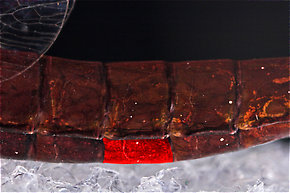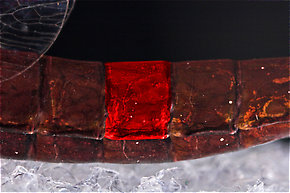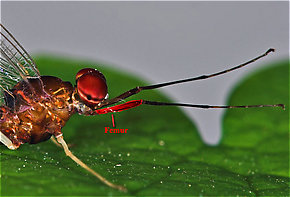Blog & Latest Updates
Fly Fishing Articles
Insects by Common Name


> > Puzzled on this Baetis nymph ID
The Specimen
Baetis tricaudatus (Blue-Winged Olive) Mayfly Nymph View 20 PicturesA nymph of the same species as this one emerged into a dun in my studio so I got photos of both stages.
View 20 PicturesA nymph of the same species as this one emerged into a dun in my studio so I got photos of both stages.
NOTE: I missed an important key characteristic the first time I tried to identify this one (robust setae (Seta: Little hairs on insects.) on the abdominal sternites ( Sternite: The bottom (ventral) part of a single segment on an insect's abdomen.), which were harder to see than I expected but are clearly present), so I went on a bit of a wild goose chase and landed at a dead end. After spotting that characteristic, this one keys more straightforwardly to either Baetis tricaudatus or the Baetis piscatoris complex. It doesn't seem to be a perfect fit for either one in the key, but I'm going with tricaudatus based on range and abundance. It's not certain.
Sternite: The bottom (ventral) part of a single segment on an insect's abdomen.), which were harder to see than I expected but are clearly present), so I went on a bit of a wild goose chase and landed at a dead end. After spotting that characteristic, this one keys more straightforwardly to either Baetis tricaudatus or the Baetis piscatoris complex. It doesn't seem to be a perfect fit for either one in the key, but I'm going with tricaudatus based on range and abundance. It's not certain.
However, I'm leaving the flawed analysis below with this disclaimer, because some aspects of how I approached that dead end might be informative in the future.
----Incorrect analysis below----
After spending a lot of time with this one under my shiny new microscope, I'm still not quite sure what it is. I botched my attempt to expose the mouth parts that might make the ID more definitive. Based on the key in Webb et al 2018's "Baetis Larvae of North America," here's my reasoning at each key couplet.
Couplet 1. The pronotum (Pronotum: The top of the insect prothorax.) lacks dark, submedian U-shaped markings. Also, if I were to follow through to couplet 2, there seem to be characteristics that rule out each of the options: the intercalaris complex is ruled out by the abdominal markings, and the caudal (Caudal: Toward the posterior tip of the body.) filaments have neither a dark median band (ruling out the flavistriga complex) nor uniform pale coloration (ruling out Baetis notos). This sends me with decent confidence to couplet 4.
Couplet 4. I cannot find robust setae (Seta: Little hairs on insects.) in my microscope on the scapes, pedicels, paraprocts, or sterna. I also do not see a pair of dark, bilobed markings on the pronotum (Pronotum: The top of the insect prothorax.). Unless I overlooked these characteristics, proceed to couplet 9.
Couplet 9. Abdominal tergum (Tergum: the dorsal part of an abdominal segment or segments (terga). Also used to describe the entire abdominal dorsum or the thoracic dorsal segments of Odonata.) 5 is a bit paler than adjacent terga (Tergum: the dorsal part of an abdominal segment or segments (terga). Also used to describe the entire abdominal dorsum or the thoracic dorsal segments of Odonata.), but "distinctly paler"? The figure for Baetis alius in the paper, as well as a very nice picture posted by Millcreek in the forum here, shows that Baetis alius would have darker tergites ( Tergite: The top (dorsal) part of a single segment on an insect's abdomen when it consists of a single chitinous plate (sclerite), or an individual sclerite if the segment has more than one.) surrounding #5. So proceed to couplet 11.
Tergite: The top (dorsal) part of a single segment on an insect's abdomen when it consists of a single chitinous plate (sclerite), or an individual sclerite if the segment has more than one.) surrounding #5. So proceed to couplet 11.
Couplet 11. The length of the gills is obviously less than 2X their width. This leads to the Baetis vernus complex, which could include that species or Baetis brunneicolor. This key doesn't say how to tell those species apart.
Switching over to Burien et al 2018 as the source, the characteristics used to distinguish vernus from brunneicolor seem to rule out either one. Brunneicolor should have more uniformly brown abdominal tergites ( Tergite: The top (dorsal) part of a single segment on an insect's abdomen when it consists of a single chitinous plate (sclerite), or an individual sclerite if the segment has more than one.), whereas vernus should have a lack of visible tracheation in most of the gills.
Tergite: The top (dorsal) part of a single segment on an insect's abdomen when it consists of a single chitinous plate (sclerite), or an individual sclerite if the segment has more than one.), whereas vernus should have a lack of visible tracheation in most of the gills.
The fore femur ( Femur: The main segment of an insect's leg close to the body, in between the tibia and the trochanter.) length is about 3.8x its width.
Femur: The main segment of an insect's leg close to the body, in between the tibia and the trochanter.) length is about 3.8x its width.
Also worth noting: In the genus ID, I thought I could see the villipore in my microscope, but I'm not sure. If I back out of Baetis altogether and assume there's no villipore, I end up at Fallceon, but this specimen doesn't seem to have the frontal keel on the head that's supposed to be present on Fallceon quilleri. So that seems like a dead end as well.
 View 20 PicturesA nymph of the same species as this one emerged into a dun in my studio so I got photos of both stages.
View 20 PicturesA nymph of the same species as this one emerged into a dun in my studio so I got photos of both stages.NOTE: I missed an important key characteristic the first time I tried to identify this one (robust setae (Seta: Little hairs on insects.) on the abdominal sternites (

One sternite of this Isonychia bicolor mayfly spinner is highlighted in red.
However, I'm leaving the flawed analysis below with this disclaimer, because some aspects of how I approached that dead end might be informative in the future.
----Incorrect analysis below----
After spending a lot of time with this one under my shiny new microscope, I'm still not quite sure what it is. I botched my attempt to expose the mouth parts that might make the ID more definitive. Based on the key in Webb et al 2018's "Baetis Larvae of North America," here's my reasoning at each key couplet.
Couplet 1. The pronotum (Pronotum: The top of the insect prothorax.) lacks dark, submedian U-shaped markings. Also, if I were to follow through to couplet 2, there seem to be characteristics that rule out each of the options: the intercalaris complex is ruled out by the abdominal markings, and the caudal (Caudal: Toward the posterior tip of the body.) filaments have neither a dark median band (ruling out the flavistriga complex) nor uniform pale coloration (ruling out Baetis notos). This sends me with decent confidence to couplet 4.
Couplet 4. I cannot find robust setae (Seta: Little hairs on insects.) in my microscope on the scapes, pedicels, paraprocts, or sterna. I also do not see a pair of dark, bilobed markings on the pronotum (Pronotum: The top of the insect prothorax.). Unless I overlooked these characteristics, proceed to couplet 9.
Couplet 9. Abdominal tergum (Tergum: the dorsal part of an abdominal segment or segments (terga). Also used to describe the entire abdominal dorsum or the thoracic dorsal segments of Odonata.) 5 is a bit paler than adjacent terga (Tergum: the dorsal part of an abdominal segment or segments (terga). Also used to describe the entire abdominal dorsum or the thoracic dorsal segments of Odonata.), but "distinctly paler"? The figure for Baetis alius in the paper, as well as a very nice picture posted by Millcreek in the forum here, shows that Baetis alius would have darker tergites (

One tergite of this Isonychia bicolor mayfly spinner is highlighted in red.
Couplet 11. The length of the gills is obviously less than 2X their width. This leads to the Baetis vernus complex, which could include that species or Baetis brunneicolor. This key doesn't say how to tell those species apart.
Switching over to Burien et al 2018 as the source, the characteristics used to distinguish vernus from brunneicolor seem to rule out either one. Brunneicolor should have more uniformly brown abdominal tergites (

One tergite of this Isonychia bicolor mayfly spinner is highlighted in red.
The fore femur (

The femur of this Isonychia bicolor mayfly spinner is highlighted in red.
Also worth noting: In the genus ID, I thought I could see the villipore in my microscope, but I'm not sure. If I back out of Baetis altogether and assume there's no villipore, I end up at Fallceon, but this specimen doesn't seem to have the frontal keel on the head that's supposed to be present on Fallceon quilleri. So that seems like a dead end as well.
Collected September 12, 2020 from the Yakima River in Washington
Added to Troutnut.com by on September 19, 2020
Added to Troutnut.com by on September 19, 2020
The Discussion
| Troutnut | November 10th, 2020, 7:32 pm | |
Administrator Bellevue, WAPosts: 2737 | I just added several microscope photos to this specimen and placed in the description my thoughts as I tried to key it out, but I ran into a dead end. Anyone have new insights? | |
| Jason Neuswanger, Ph.D. Troutnut and salmonid ecologist | ||
| Millcreek | November 11th, 2020, 6:10 am | |
| Healdsburg, CA Posts: 356 | First thought,Baetis tricaudatus. No real reason, just overall gestalt. There's another key by Webb, Jacobus and Sullivan. I haven't had time to go through it yet, but it looks pretty good overall. You can download it here:https://www.mapress.com/j/zt/article/view/zootaxa.4394.1.6/0 Actually, you can't. Type in a google search for state of systematics of north american baetis. Go to Researchgate. you can get the pdf for free. | |
| Troutnut | November 12th, 2020, 11:27 am | |
Administrator Bellevue, WAPosts: 2737 | Thanks Mark. I think your sense of the gestalt was probably right. I've updated the description of this specimen after taking another look with the new microscope and noticing robust setae on the sternites (hard to see!). I think tricaudatus is the most likely, so I'm tentatively putting it there. The length:width ratio of the femora doesn't seem to match the key characteristics for tricaudatus, but it doesn't seem like a great match for the piscatoris complex either. | |
| Jason Neuswanger, Ph.D. Troutnut and salmonid ecologist | ||
Quick Reply
You have to be logged in to post on the forum. It's this easy:
Related Discussions
| Title | Replies | Last Reply |
| Baetis adult species IDs? In Male Baetis tricaudatus Mayfly Spinner by Troutnut | 0 | |
| Interesting caddisfly for Roger/Taxon In Lepidostoma Little Brown Sedge Larva by Troutnut | 0 | |
| Re: Another Anthopotamus In the Photography Board by Crepuscular | 4 | Jun 16, 2012 by Entoman |
| Re: Gender In Female Hesperophylax designatus Caddisfly Adult by JpMcKenzie | 1 | Dec 16, 2017 by Creno |
| Re: Baetis bicaudatus In Male Baetis tricaudatus Mayfly Spinner by Taxon | 12 | Nov 12, 2020 by Millcreek |
| Re: Not Stenonema femoratum In Stenonema femoratum Mayfly Nymph by Dewalt | 4 | Jun 12, 2013 by Entoman |
| Re: microscopes In the Photography Board by Minnowbait | 2 | Mar 21, 2016 by Entoman |
| Re: Related Baetis Topic In General Discussion by Lastchance | 1 | Feb 4, 2012 by PaulRoberts |
| Re: Diphetor In Baetis Mayfly Nymph by Earlfishman | 5 | Apr 13, 2007 by Troutnut |
| Re: Spinadis simplex In Female Heptageniidae Mayfly Dun by Taxon | 1 | Jul 20, 2019 by Troutnut |
Troutnut.com is copyright © 2004-2024 Jason
Neuswanger (email Jason). See my FAQ for information about use of my images.
 privacy policy
privacy policy

